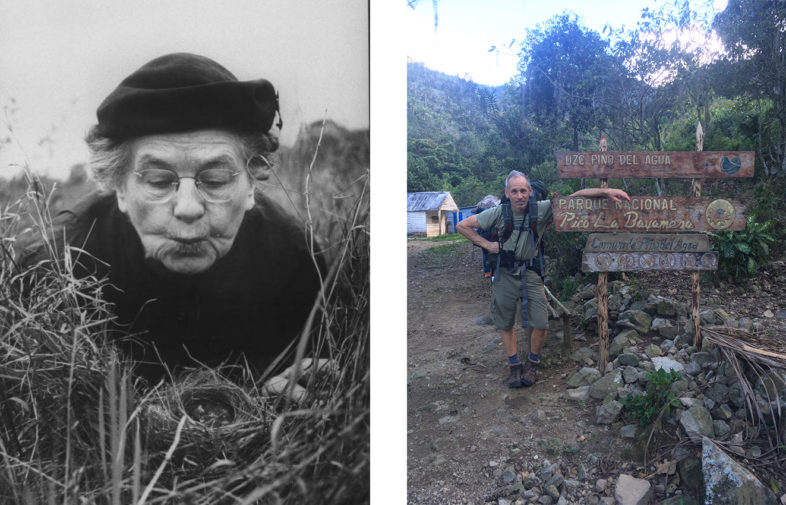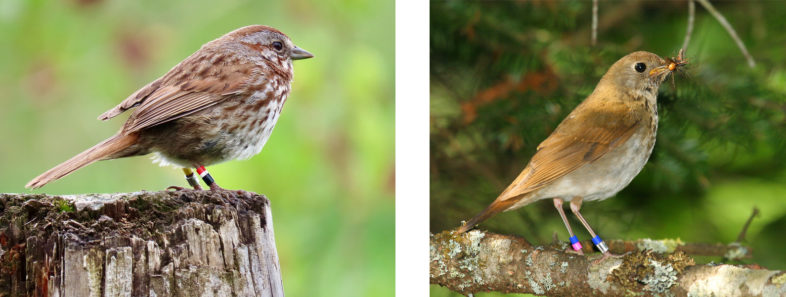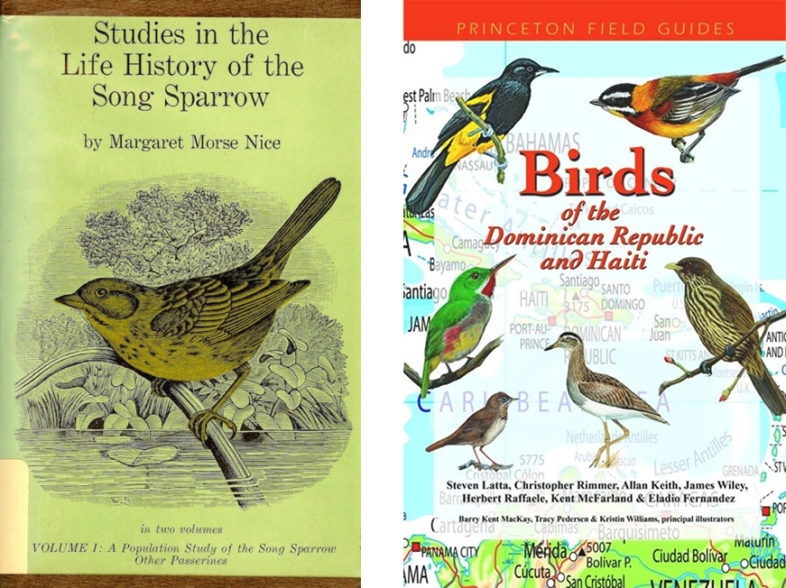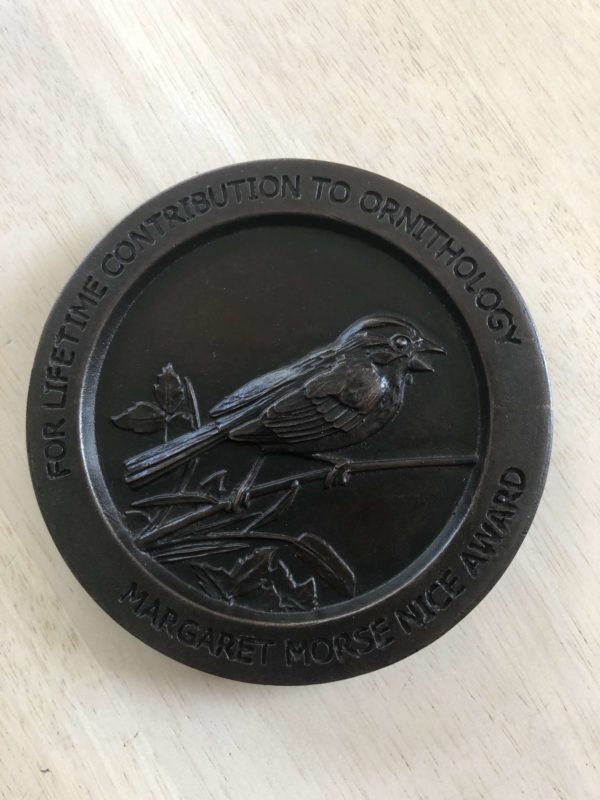
Left: Margaret Morse Nice in her field finery observing a Field Sparrow nest; photo by Al Fenn c.1956. Right: Chris Rimmer at the outset of a backpacking trek into Cuba’s remote Bayamesa mountain range, February 2019.
Nearly 100 years ago, a mother of five with an abiding passion for and curiosity about the lives of birds quietly launched a study in her Columbus, Ohio, backyard. Margaret Morse Nice couldn’t possibly have foreseen the enormous influence of her homegrown project on the field of ornithology. Meticulously observing two pairs of nesting Song Sparrows during that inaugural season of 1929, over the next seven years, Nice chronicled every life history aspect of dozens of pairs on the 24-hectare (60-acre) area adjoining her home. Her work, which culminated in the 1937 and 1941 publications Studies in the Life History of the Song Sparrow (Vol I and II), revolutionized ornithology. As it turns out, her groundbreaking approach to bird study also provided an inspirational model for VCE’s own investigations of Bicknell’s Thrush (BITH), now in their 31st year.
VCE was recently recognized for its hemispheric body of work on BITH, as the Wilson Ornithological Society awarded Chris Rimmer its Margaret Morse Nice Medal at the society’s annual meeting in Santa Fe, NM. This prestigious lifetime achievement award bears testament to VCE’s dedicated pursuit of the ecology and conservation of this rare, range-restricted songbird. Following Nice’s tried and true approach of examining every possible facet of BITH life history, behavior, and ecology, Rimmer and the VCE team have scoured mountaintop forests from Canada, New England, and New York to Hispaniola, Cuba, and Puerto Rico. Their discoveries have yielded many surprises—from the species’ unique mating system to its skewed adult sex ratio (two males for every female), to its habitat segregation in the winter range, to the ubiquity of toxic mercury in blood and feathers—and forged many vital conservation connections across BITH’s migratory range.
In retrospect, Nice’s innovative approach was a simple one—to closely track the lives and habits of individual breeding Song Sparrows in her Ohio backyard over many years. Her pioneering work set the bar for what are now known as longitudinal studies, or those that follow individual organisms over time. In 1929, when Nice launched her landmark study, behavior and ecology had barely entered the ornithological research lexicon. When VCE dipped its toes in the Bicknell’s Thrush waters more than 60 years later, her field methods still constituted the gold standard, as they do today. It’s not so much that Nice made dramatic scientific discoveries; instead, she demonstrated how to thoroughly document the life history of an animal by collecting copious amounts of high-quality data across many individuals and multiple years. Now the benchmark in organismal population studies, this approach was truly revolutionary at the time.

Margaret Morse Nice’s studies of Song Sparrows (left) paved the way for VCE’s research and conservation efforts on Bicknell’s Thrush (right) over 60 years later. Photos © Nathaniel Sharp (left), Charles Gangas (right)
Overall, few direct similarities exist between Song Sparrows and BITH, except that they’re both members of the avian order Passeriformes, or perching birds. And although Margaret Morse Nice pioneered the approach that VCE adopted to investigate BITH, our studies have been far more geographically extensive and technically intensive than was possible for hers. Nice had few technological tools at her disposal in the 1930s, though she ingeniously improvised a system of color-banding her birds for individual identification by fashioning color bands from brightly-colored plastic children’s toys! VCE, on the other hand, has used every trick in the book, including videography at nests, mtDNA analyses to examine paternity, radiotelemetry to find nests and document home ranges, and light-level geolocators and GPS tags to determine large-scale movements.

A color-banded adult Song Sparrow (not one of Margaret Morse Nice’s study subjects) and a uniquely color-banded adult Bicknell’s Thrush on Mt. Mansfield. Photos: © Leslie Schweitzer (left), Bryan Pfeiffer (right)
Margaret Morse Nice’s productivity and influence tower over those of nearly any other ornithologist in history. An “outsider” in that she lacked a formal professional position or funding to pursue her studies, Nice nonetheless participated ardently in ornithological societies and meetings, was a consummate networker, and authored 3,000 reviews on books and other ornithological literature. Over her career, she published nearly 250 scholarly articles, including seven book-length research monographs, and several books. VCE’s work on BITH doesn’t achieve those lofty publishing standards, but we’ve held our own in the publishing realm, with 45 peer-reviewed papers that focus on or include the species, 20 or more papers that are “spin-offs” from our work on BITH (mostly involving Caribbean birds), and two field guides to the birds of Hispaniola. It is hard to imagine how Margaret Morse Nice could possibly been so prolific!

Margaret Morse Nice’s two-volume monograph on Song Sparrow life history, published in 1937 (left) and 1941, remain a benchmark for rigorous, longitudinal avian research. VCE was closely involved in publishing the first-ever field guide to the birds of Hispaniola, with a trilingual (English, Spanish, and French) first edition published in 2006 (right) and a revised second edition in 2022.
Nice’s many accolades include testimonials from Nobel Prize winner Konrad Lorenz, who called her Song Sparrow work a “major breakthrough in the methods of studying animal behavior.” Harvard University’s Ernst Mayr considered it the “finest piece of life history work ever done” and that she “almost single-handedly initiated a new era in American ornithology.” VCE’s longitudinal work on BITH, now in its 31st consecutive year, may embody Margaret Morse Nice’s pioneering approach to avian life history studies, but we harbor no illusions that our influence is anywhere close to hers. We are, however, sincerely grateful, truly honored, and deeply humbled to have our work considered in the same breath as this most remarkable woman’s.


Well deserved honor and kudos to you, Chris!!
OhChris! Many Congrats👏👏👏So well deserved! I had no idea about Margaret M. Nice; she’s so like our founder, Navel Osgood Wright.
Kudos to all the group, I love that Steve Latta, have a great history of banding with him and Fred Sibley in CR and Tortola.
Congratulations Chris!!!!
Congratulations Chris and to everyone involved in the BITH research!
Congratulations Chris and your entire team for the fantastic work done! Also, thank you, for explaining the work of Margaret Nice. I haven’t heard of her before, which is a shame as she seems like a terrific example of a woman in science, so I’ll be sure to talk about her story with my peers.
Congratulations to the whole BITH team and to Chris, for his steadfast devotion to this species. Great article too. How did Margaret Morse Nice do all that research and raise 5 kids too! WOW!
Congratulations Chris and to all of VCE’s Bicknologists!